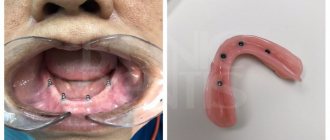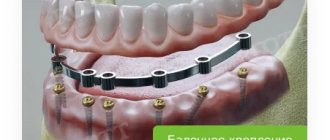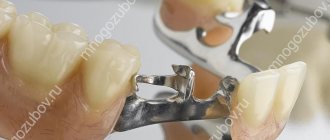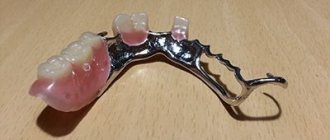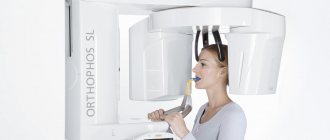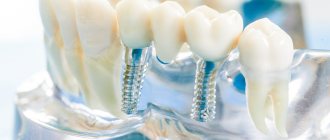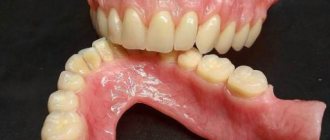There are many methods for restoring teeth in dentistry. Each of them has its advantages and helps solve a specific problem. However, implant prosthetics are considered the most effective.
The basis of the method is the implantation of titanium pins into the jawbone, which replace the roots of natural teeth. An orthopedic structure is installed on top of the pin, depending on the condition of the dentition.
The technology is applicable to restore one tooth, several dental units in a row, or the entire jaw at once. In the first case, an artificial crown is fixed on the implant, a bridge structure is used to replace 2-3 teeth, and when all teeth are restored, a fixed or removable prosthesis is used. The doctor selects the material for the orthopedic design based on the method of installing the prosthesis, the preferences and financial capabilities of the patient.
Pros of technology
Some will say that dental implantation is very expensive. But if you evaluate the result in perspective, it turns out that this is a profitable investment in your own health for the next 20-25 years.
Judge for yourself: the service life of prostheses on implants is 2-3 times longer than traditional designs. And the titanium pin ensures an even load on the jaw, while maintaining chewing and speech functions.
In addition, the use of implants when installing dentures allows you to restore any number of teeth, regardless of their location in the oral cavity.
In case of edentia (complete absence of teeth), implants can be used to place not only a removable, but also a permanent orthopedic structure, which in its properties is much more convenient and reliable.
Uniform load on the jaw eliminates bone tissue atrophy and subsequent problems with natural teeth. In addition, implant prosthetics do not use healthy teeth. Nothing is attached to them; natural teeth do not need to be ground down, which significantly extends their life.
Dentures are comfortable to wear: they do not injure the gums, do not distort diction, and do not shift under load.
But the main advantage is the high level of aesthetics. All types of dentures installed on implants look like real teeth.
Types of prostheses on implants
Prosthetics on implants with complete or partial absence of teeth is carried out using various methods. In addition, the patient's individual preferences and clinical presentation are taken into account. Today, the following types of structures on implants are known: conditionally removable , removable and non-removable . Each type has its own characteristics and advantages. Next we will look at each type separately.
The crown for the implant can be made of metal ceramics and zirconium dioxide. This type of prosthetics is used when one or more teeth are lost and, if desired or necessary, each tooth can be restored with an implant. If a significant number of teeth or all teeth on the jaw are missing, then a dental bridge on implants is used. In this case, a small number of implants are fixed on the jaw and a bridge is fixed based on them.
So, for example, if six teeth are lost, the integrity of the dentition in the specified defect can be restored by using three implants, on which 6 crowns will be attached. Also, a permanent structure can be fixed on six implants, restoring the entire dentition on a toothless jaw. Such a dental prosthesis made of metal-ceramics or zirconium dioxide is made using the “all-on-6” technology. At the same time, it is possible to apply the technology of implantation and prosthetics on “all-on-4” implants, in which a conditionally removable acrylic structure will be fixed on four implants with micro-locks to restore a full dentition.
[]
Types of structures
In general, implant-supported prostheses are divided into two types:
- Removable.
- Fixed.
The first type differs significantly from analogues of classical prosthetics. Traditional structures are fixed exclusively on the gums, or attached to supporting teeth. Thanks to implants, removable dentures are securely fixed in the jawbone, but they can be removed if necessary. That's why they are called conditionally removable.
Fixed dentures are considered a more durable and optimal option for dental restoration. In addition to the artificial crown, some types of structures are equipped with a base made of elastic plastic, which imitates natural gums.
Fixed dentures can be used to replace any number of teeth, even if they are located in different parts of the dentition. We will talk in more detail about each type of prosthesis a little later.
There are also temporary dentures that are installed during the period of fusion of the implants with the jawbone. They maintain the aesthetics of the dentition and reduce the mechanical load on the pins, speeding up the healing process.
Temporary dentures look like removable structures that hook onto supporting healthy teeth using hooks. The most common option is a butterfly-shaped prosthesis. It is equipped with a plastic gum and two plastic holders for adjacent teeth. A denture replaces one or more teeth in a row.
Advantages
In comparison with conventional removable dentures, designs supported by implants differ favorably in terms of reliability of fixation, service life and other characteristics.
| Classic dentures | Dentures on implants | |
| Reliability of fixation | not securely fixed, may fall out | securely fixed (fastening parts are located inside the prosthesis) |
| Duration of addiction | rub the mucous membrane, create discomfort | quick adaptation due to small size |
| Bone atrophy | do not stop the process of bone atrophy | pauses when the chewing load is evenly distributed (beam fastening) |
| Effect on gums | dentures put pressure on the gums, which lose their shape and atrophy | practically no pressure on the gums |
| Relocation | require regular relining due to sagging fabric | relocation is needed in the first months |
| Food restrictions | Do not eat hard, sticky foods | no restrictions |
| Difficulty of care | after every meal | periodically to remove plaque and clean the abutments |
| Life time | up to 5 years | up to 10 years with proper use |
Installation steps
The reliability of implant-supported dentures directly depends on the location of fixation. Especially when it comes to restoring all teeth. Correct placement of implants will ensure uniform distribution of chewing load on the jaw and allow the use of a minimum number of pins. This reduces the recovery period and the degree of surgical intervention during installation.
At the initial stage, the implantologist performs an initial examination of the oral cavity. In EspaDent clinics, to select a prosthetic method, additional diagnostics are carried out using a modern Orthophos SL 3D tomograph, which takes three-dimensional, layer-by-layer images of both jaws. Professional equipment allows you to simulate the treatment process and show the patient the final result.
In the absence of contraindications, the doctor proceeds to the next stage of prosthetics on implants - fixation of titanium pins in the jawbone. The procedure takes 40-60 minutes for each implant. It is carried out using anesthesia. Our specialists use safe painkillers. They are non-toxic and do not cause allergic reactions.
The pin fixation process includes:
- Gum section.
- Preparing the space in the jawbone.
- Implant installation.
- Gum stitching.
The period of fusion of the pin with the bone tissue takes 3-4 months. During this time, the patient is fitted with temporary removable dentures, which we discussed above.
After the healing process is completed, the doctor installs a gum former and takes an impression of the teeth. After a couple of days, the adapter is replaced with an abutment, on which the finished denture is fixed.
What is the time frame for prosthetics on implants?
They are directly dependent on the healing time (osteointegration - fusion with bone tissue) of the implant and on what implantation method was used during the installation process. On the lower jaw, it is possible to begin permanent prosthetics after 3 months; on the upper jaw, a time interval of 4-6 is maintained. These conditions must be met in the case of classical one-stage or two-stage implantation. If there is a lack of bone and osteoplasty or sinus lifting is performed (replenishment of bone deficiency), the time from installation of implants to prosthetics increases.
How long does prosthetics take?
The duration of installation of prostheses on implants depends on the clinical situation. After performing a tomography of the jaw, the doctor assesses the condition of the bone tissue. Depending on the degree of jawbone atrophy, the implantologist may prescribe an osteoplasty procedure.
The period of prosthetics on implants is determined by the rate of bone tissue regeneration, as well as the chosen installation technique. For example, the healing period of implants in the upper jaw takes, on average, 3-4 months. For the lower jaw a little less - 2-3 months.
If a procedure is carried out to restore bone tissue due to atrophy, then another 2-4 weeks are added to the installation of prostheses.
Gum contour.
A very important point in implant prosthetics is maintaining the gum contour. If an inexperienced implant surgeon misses this point, then the patient’s dissatisfaction may begin to express itself due to aesthetic complaints: the gums around the implant are blue, there are no gingival papillae, and they play a big role in the aesthetic component. To the point that over time (can happen in a very short time) the patient develops a problem with gum loss (gingival recession) and exposure of the implant neck. In our Es-Dent dental center, according to indications, close attention is paid to gum plastic surgery. If an implantologist says that a procedure with the gums is necessary, you should not ignore this stage of treatment in order to avoid problems after the installation of the prosthesis.
Why there are problems with gums.
- A person may naturally have thin gums. Its ideal thickness is 5 millimeters. If the patient’s skin is twice as thin, then one can definitely expect poor-quality aesthetics after prosthetics (if appropriate therapeutic measures are not taken). This will be, at a minimum, unsightly, and at maximum, it will lead to exposure of the implant.
- Attached gum. There may be a deficiency of this type of gum. Ideally, the gums should grow tightly together with the periosteum - this is the attached gum. But the second type is mobile. The results of ignoring gum surgery are the same as with the thin biotype.
The graft for gum plastic surgery is taken from the patient himself in certain places in the palatal space.
Prosthetics using removable structures
When is it advisable to use removable dentures on implants? Often the argument is limited budget. Removable structures are much cheaper than permanent ones, especially in the case of complete edentia.
The method is effective for severe atrophy of the jaw bone, if the patient is not ready to undergo a sinus lift of the jaw. A denture with artificial gum will hide imperfections in the contour of your own tissues.
Conditionally removable structures are fixed to implants in two ways: screw or beam. In the second case, a metal structure in the form of a beam is used, on which artificial teeth are installed. The beam serves as the base of the prosthesis and ensures uniform distribution of mechanical load on the bone. Due to the single design, the prosthesis is more stable.
Both options for fixing the prosthesis can be removed if necessary (for cleaning, etc.). However, only a dentist should do this.
What is the difference between classic removable dentures and those installed on implants? The design with pins is smaller in size and has better fixation in the oral cavity, which ensures comfortable wearing.
The absence of a palate in the prosthesis preserves taste sensitivity when eating food, without any restrictions.
The ability to remove the prosthesis extends its service life and allows for timely cleaning and replacement of elements, if necessary.
Lower cost makes this type of implant prosthetics accessible to most patients.
If we talk about size, fixed dentures are more neat and compact. From an aesthetic point of view, removable ones are also inferior to non-removable ones. The latter do not have artificial gums.
To make crowns in removable dentures, the following is used:
- Plastic (for temporary fixation).
- Ceramics.
- Zirconium dioxide.
All materials have increased strength and high aesthetics. At EspaDent clinics, crowns are made using digital CAD/CAM technology. The automatic production mode eliminates the occurrence of errors associated with the human factor. Dentures take into account the anatomical structure of the patient’s jaw and the location of adjacent teeth. Their installation does not change the bite, does not deform the masticatory muscles, and does not cause facial asymmetry.
Contraindications to implantation and alternatives
- Complex pathologies of the cardiovascular system
- AIDS, HIV
- Oncology
- Diabetes
- Blood clotting problems
- Severe bone diseases
- Age up to 18 years
- Alcoholism, drug addiction
- Dental and periodontal diseases
- Pregnancy and lactation
If the installation of full titanium roots is contraindicated for a patient, then dentists offer the following alternative solutions for complete edentia:
- fixation of removable teeth on mini-implants that integrate into the upper layers of bone tissue. Therefore, the prosthesis cannot bear a full chewing load;
- production of removable dentures “with suction cups” without implantation.
Fixed structures
As a rule, crowns or bridges are used for fixed prosthetics on implants. A single denture most accurately replicates the shape and appearance of the missing tooth. Using single crowns, the implantologist corrects the gum contour, making it almost ideal. This is especially true for the front teeth that fall into the smile zone.
A bridge structure is used to restore several teeth. It is necessary in cases where it is not possible to install 2-3 implants in a row due to lack of space.
The difference from a traditional bridge lies in the method of fastening. The structure receives additional support in the form of pins and does not affect adjacent healthy teeth. In other words, there is no need to grind down your natural teeth and attach a prosthesis to them.
The advantages of the technique include the maximum degree of stabilization of the prosthesis, high aesthetics and a tight fit of the structure to the gum, which eliminates its damage and the ingress of food debris into the prosthesis.
The only disadvantage of fixed dentures on implants is the price. But in fact, this is the most profitable investment in your own health. The durability of the implants and the lifetime guarantee for their installation only confirms the quality of the technique.
Production of clasp dentures on a fire-resistant model
The complex structure, which is the clasp denture, is made by dental technicians. To obtain an accurate frame, modeling and casting from special wax is carried out on a fireproof model. It is made on the basis of a conventional plaster model.
An induction casting machine is used to cast a metal clasp blank. Acrylic teeth are then placed on the wax model. The technician sends a mock-up of the prosthesis to the patient to try on. The dentist carefully checks the clasp in all respects: the accuracy of the prosthesis fit on the gum, the quality of the bite, the tightness of the fit to the teeth. After correcting the deficiencies identified by the dentist, the technician replaces the wax base with a plastic one.
There are differences in technologies for the production of clasps with other types of fastenings, for example, with telescopic crowns, but they are not very radical.
In the manufacture of some types of prostheses, such as Quadrotti, the base of the clasp is made not of metal, but of plastic.
Restoration of teeth with complete edentia
The method of fixed prosthetics effectively copes with the problem of complete absence of teeth. For example, All-on-4, All-on-6 protocols or simultaneous implantation.
The All-on-4 protocol involves the installation of four implants in the jaw: two in the frontal part, two on the sides, at an angle to the jaw.
The technology provides instant chewing load, immediately after fixing the prosthesis. Installation of the prosthesis is possible immediately after implantation.
If the patient has severe jawbone atrophy, the All-on-6 protocol is used. An additional number of implants ensures reliable fixation of the prosthesis even with insufficient bone tissue.
But be careful! Due to the popularity of the technology, many fakes have appeared. Poor quality materials and unprofessional work can lead to serious health complications and loss of money.
EspaDent is an official partner of Nobel Biocare, a leader in implantology and developer of protocols for dental restoration in 1 day.
In 2016, with the support of Nobel Biocare, our clinic created its own Implantation Center, which provides training to specialists from all regions of Russia.
Stages of prosthetics
- Preparation.
The doctor determines the size of the bone and excludes contraindications - the patient is given an X-ray, CT or OPTG, and sent for tests. Sanitation of the oral cavity is carried out. In case of bone deficiency, if there are no areas of the jaw with sufficient tissue volume, osteoplasty is performed before classical implantation. - Installation of implants.
In the classical protocol, implantation is organized using the patchwork method, and after implantation of titanium roots, sutures are applied. Mini-products are screwed into the bone through small holes (without cutting tissue or sutures). - Prosthetics.
With the classic protocol, the dentures are securely fixed in the mouth after the artificial roots have completely engrafted (after 3-6 months). During this time, the patient wears conventional removable dentures. When choosing mini-models, the prostheses are fixed 2-3 days after surgery.
Important!
When installing any orthopedic structures supported by their own teeth or implants, the patient should not feel discomfort. An incorrectly selected prosthesis leads to disruption of the chewing muscles and jaw joint. In our Center, all prosthetic work is carried out taking into account the patient’s bite characteristics; in difficult situations, consultations and treatment are provided by a gnathologist.
Materials for dentures
To attach prostheses to implants, the material must be highly durable or have a metal base. This is necessary for the structure to withstand the load of the abutment (adapter).
Crowns for fixed structures are made from metal-ceramics, composite, metal-plastic, and also from zirconium dioxide. The prosthesis is attached using cement or screws.
Composite crowns with a metal frame are used for single replacements, as well as for the installation of bridges. The design has a long service life (10-12 years) and is subject to repair. Reliable, lightweight, with a high degree of aesthetics, composite crowns are comfortable to wear and look like real teeth.
Plastic removable dentures last no more than 5 years and are used only for temporary or adaptive prosthetics. At EspaDent clinics, our specialists use more technologically advanced plastic for temporary prostheses. The composition contains crushed diamond chips, which makes the structure more resistant to stress during the fusion of the implant with the bone.
Fixed prosthesis is made of zirconium or metal ceramics. This is due to the high reliability of the design. Crowns cannot be restored, as is the case with composite crowns, so they must be as strong and durable as possible. For metal-ceramics, the service life is 8-10 years, and zirconium is a little longer - 15-17 years.
The disadvantages include the imperfect aesthetics of ceramic crowns - the metal base can be visible in the light. Therefore, it is better to use them to restore lateral teeth.
Zirconium dioxide crowns have almost no disadvantages. Decent service life, impeccable appearance, increased material strength, absence of allergic reactions even in patients with high sensitivity. Of course, such prostheses are more expensive than their analogues.
What are implants made of?
Commercially pure titanium is most often used for the production of implants. A distinctive feature of this high-strength material is its ability to take root without problems. The titanium rod of the implant is not rejected by the body, since it is not perceived by it as a foreign body. The only contraindication for use is individual intolerance to titanium. In this case, implants are made from other materials.
Sometimes implants are made of zirconium dioxide. The advantage is that dioxide implants do not show through the gum mucosa, which sometimes happens with titanium ones. But the main disadvantage of zirconium dioxide is the poor adherence of implants to jaw tissue and the difficulty of subsequent processing of the implant rod, therefore implants made from it are not often used in dentistry.
Contraindications
It is obvious that implant prosthetics is a complex and expensive procedure. Therefore, even at the initial stage, it is important to eliminate all possible risks for the patient.
The reason for refusal or delayed treatment may be jaw deformation, pathological atrophy of bone tissue, bruxism, increased tooth wear, and malocclusion. Contraindications to surgery are also diseases of the nervous system, bleeding disorders, reduced immunity, intolerance to painkillers, and the presence of tumors.
EXAMPLES OF PROSTHETICS USING BIOTECHNOLOGICAL BAR
Our clinic achieves the highest aesthetic and functional results of prosthetics, make sure of the quality of the work!
IN THE PHOTO: PROSTHETICS USING BIOTECHNOLOGICAL BUGEL PROSTHETICS
IN THE PHOTO: PROSTHETICS USING BIOTECHNOLOGICAL BUGEL PROSTHETICS
IN THE PHOTO: PROSTHETICS USING BIOTECHNOLOGICAL BUGEL PROSTHETICS
IN THE PHOTO: PROSTHETICS USING BIOTECHNOLOGICAL BUGEL PROSTHETICS
IN THE PHOTO: PROSTHETICS USING BIOTECHNOLOGICAL BUGEL PROSTHETICS
If you are interested in this orthopedic design, we recommend that you familiarize yourself with it in detail:
Care instructions
In order for implant-supported dentures to last as long as possible, they require careful care. Each patient receives written information about how to care for fixed or removable dentures after the procedure.
Special toothpastes and brushes are used to clean dentures. It is easier to take care of removable structures, because... You can easily remove the prosthesis. For this purpose, it is recommended to visit the dentist's office, who will professionally clean the dentures.
To remove food debris from interdental crevices and hard-to-reach places in the structure, you need to use dental floss, brushes and irrigators.
Remember, proper care of the prosthesis and careful use significantly extends its service life.
Pros and cons of installation
Advantages of the prosthesis:
- When installing a metal-ceramic crown, the color of the enamel of an artificial tooth does not differ in any way from the natural one;
- The integrity of adjacent crowns is preserved; this service does not require their turning;
- Durability of bridge and clasp implants (5-8 years).
Flaws:
- High cost of implantation;
- Allergic reactions to the composition or anesthesia;
- Long treatment period;
- Inability to chew solid food (tough meat);
- Removable structures need to be changed once a year;
- When broken, bacteria and pieces of food get under the product, and the process of rotting begins.
Removable dentures on implants consist of two parts: visible and invisible. The first represents metal roots that are screwed into bone tissue. The second is dental crowns or other prosthetics.
Are there any disadvantages to clasp dentures?
Of course there is. Many patients do not like the fact that they have to be removed periodically. Installation of a prosthesis is possible only after preliminary preparation of your teeth (grinding, if necessary, depulping, covering with crowns, etc.). Abutment teeth are subjected to severe stress, which can destroy them over time. Some types of fixation are noticeable at close range. The chewing load is distributed between the supporting teeth and gums. After prolonged use, bone tissue atrophy occurs in the area of missing teeth.
In addition, there is a risk of the patient developing an allergic reaction to the metal from which the prosthesis frame is made.
And, of course, it takes gradual getting used to the dentures - at first they are very noticeable in the mouth. And any deviation from physiology in the oral cavity causes discomfort.
Prosthetics on mini-implants
In addition to conventional pins, minimally invasive smaller models can be used to attach removable devices, allowing prosthetics to be performed immediately after implantation. Patients choose them if it is impossible to install classic artificial roots or if they want to save money. Miniature products have almost no contraindications; they can be installed even with significant thinning of the bone tissue.
But mini-implants also have a significant drawback. Due to their small size, they are unable to withstand significant loads for a long time, which reduces their service life to 2–3 years. In the future, they will cause the same discomfort as conventional removable dentures.
Doctors specializing in the manufacture of biotechnological clasp prosthesis
Specialists who perform prosthetics using this technique must meet the qualification requirements:
Have a higher medical education in dentistry
Have a Certificate of Specialist in Prosthodontics
Have a Certificate in Dental Surgery
Have a Certificate from Bio Ortho Technology for the installation of a biotechnological clasp prosthesis
In our clinic, prosthetics with this design are performed by Dr. Petr Vladimirovich Ozerov, the chief physician of the clinic, with 20 years of experience.
We invite you to undergo prosthetics using a biotechnological clasp prosthesis at the Bionic Dentis clinic!
What does the prosthesis consist of?
The elements that are part of the clasp prosthesis include:
- A metal arch that plays the role of the base of the prosthesis and is called a clasp.
- Artificial gum made of plastic.
- Artificial teeth - crowns.
To attach products to implants, special abutments or beams are used.
Patients often complain that the metal arch (clasp) rubs the soft tissues. This is the main disadvantage of the clasps under consideration. It should also be noted that these designs take quite a long time to get used to.
What to choose: clasp denture or implant?
As you can see, a more physiological option is to install implants. This option also provides complete restoration of the function of a lost tooth. If you focus on aesthetics, this option also wins.
Clasp dentures are also a modern, high-quality method of removable prosthetics. But, if we compare them with implantation, they win only in terms of the financial part of the issue. They can also be preferred in situations where implantation is impossible for some reason.
In any case, it is better to make the final decision after consulting a dentist. He will determine whether there are any contraindications or other health conditions and will select the optimal treatment option.

